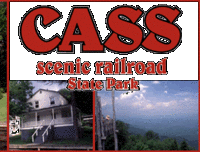Cass Scenic Railroad State Park
Cass Scenic Railroad State Park, in Cass, Pocahontas County, West Virginia, is a West Virginia State Park heritage railway consisting of the town of Cass, eleven miles of railway, and a portion of the summit of Bald Knob.
<googlemap lat="38.442027" lon="-79.919701" type="map"> 38.44855, -79.926735, Cass Scenic Railroad State Park </googlemap>
Contents
History
Founded in 1901 by the West Virginia Pulp and Paper Company, now Westvaco, Cass was built as a company town to serve the needs of the men who worked in the nearby mountains cutting spruce and hemlock for the West Virginia Spruce Lumber Company, a subsidiary of WVP&P. At one time, the sawmill at Cass was the largest double-band sawmill in the world. It processed an estimated 1.25 billion cubic feet of lumber during its lifetime.
In the 1940s, WVP&P sold the Cass operation to Mower Lumber Company, which operated the line until 1960, cutting second-growth timber off the Cheat Mountain. In 1960, Cass was abandoned due to rapid decline of the timber industry in the region. The rail line at Cass and the Shay locomotives (the only steam engines capable of maneuvering the steep grades on the mountain) were planned to be scapped, but Pennsylvania railfan Russell Baum purchased the line and convinced the legislature to make Cass Railroad a state park. In 1963, the first train left the Cass depot for Whittaker Station (four miles up the line) with tourists, not timber.
Shay Locomotives
Ephraim Shay (1839-1916), has been credited as a schoolteacher, physician, civil engineer, logger, merchant, railway owner, and inventor. He lived in Michigan, and became a logger in the 1860s. While a logger he wanted to find a new way to get logs to the mill, besides floating them on a river. He then built his own tramway in 1875, on 26 in. track, and wooden ties. This was very efficient and enabled him to beat his competitors because he saved so much money with the tram. Two years would pass before he would invent the Shay Locomotive. In about 1877 he developed the idea of having an engine sit on a flat car with a boiler, gears, and trucks that could pivot. The first Shay only had two cylinders and operated through a series of gears over the inside portion of the rear truck. It did not take long for this idea to become popular. When Lima Locomotive Works received the Shay idea it was not impressed, but a man by the name of John Carnes influenced the company to take the idea and expand upon it. What resulted was the classic Shay design we see today. During its lifetime, Lima Locomotive Works manufactured nearly every Shay, including the last and largest Shay, which is still in operation at Cass.
Current operations
Today, riding on historic converted log cars, pushed along by the powerful Shay locomotives, you can take a step back into history. Traveling on 11 miles of track laid in 1901 by immigrant workers, you will be traversing the steep grades of Cheat Mountain. The railroad owns eight Shay Locomotives, one Heisler locomotive, and one Climax locomotive, which as of 2001 was being restored by the Mountain State Railroad and Logging Historical Society.
Three trips are available: a two-hour round trip to Whittaker Station, a five-hour round trip to the ghost town of Spruce (once the coldest and highest town east of the Rockies), and a five-hour round trip to Bald Knob, the second highest point in the state.
Former company houses have been refurbished and are rented to visitors.
Town and shop tours are available to visitors who would like to learn more about the operations and history. A tour of a restored logging camp is available at Whittaker.
Videos and pictures
<flickr "limit=10">"Cass Scenic Railroad"</flickr>
See also
- List of heritage railways
- List of West Virginia state parks
- Bald Knob
- Leatherbark
- Pocahontas County, West Virginia
- State park
External links
References
- Withers, Bob (August 25 2005), Cass railroad line to mark birthday. Retrieved August 25 2005.
- Iverson, Clark (1965), On Beyond Leatherbark.



